Vittorio Garatti | |
|---|---|
| Born | 6 April 1927 Milan, Italy |
| Died | 12 January 2023 (aged 95) |
| Alma mater | Polytechnic University of Milan |
| Occupation | Architect |

Vittorio Garatti (6 April 1927 – 12 January 2023) was an Italian architect. [1]
Vittorio Garatti | |
|---|---|
| Born | 6 April 1927 Milan, Italy |
| Died | 12 January 2023 (aged 95) |
| Alma mater | Polytechnic University of Milan |
| Occupation | Architect |

Vittorio Garatti (6 April 1927 – 12 January 2023) was an Italian architect. [1]



Garatti was born in Milan on 6 April 1927. He graduated in architecture in 1957 from the Politecnico di Milano, where Ernesto Nathan Rogers was a major influence. Guido Canella and Gae Aulenti were his classmates.
In that same year, Garatti departed for Venezuela, where he found employment in the Banco Obrero project led by architect Carlos Raúl Villanueva, and began teaching at the University in Caracas. Garatti, like fellow architect and Banco Obrero project mate Roberto Gottardi, had been a young participant in the post-war debate in Italy against Rationalism, a critique that was led by such figures as Ernesto Nathan Rogers, Carlo Scarpa, Mario Ridolfi, Giuseppe Samonà and Bruno Zevi.
Following the victory of the Cuban Revolution, Cuban-born architect (and Banco Obrero participant) Ricardo Porro invited Garatti and Roberto Gottardi to join him in Havana in early 1961. Garatti soon began work with Porro and Gottardi on the ambitious project of Havana's new National Art Schools, commissioned by Fidel Castro and Che Guevara, in the context of the educational policy promoted immediately after the revolution. The architectural complex was to be built in the most exclusive upper-class Cuban district, [2] the Country Club. The intention was to create a cultural center of extraordinary dimension, opened to the developing countries of three continents, just 90 miles from the symbol of American imperialism.
Garatti designed the School of Music and the School of Ballet [3] as a complex of bricks, pottery, and Catalan vaulted structure that reflected the optimism and exuberance of the time. The schools wanted to reinvent the architecture, as the revolution was hoping to reinvent society.
Vittorio Garatti writes: "We took care to invade as little as possible the golf. We located several schools on the outskirts of the park, closer to the upper-middle class houses arranged along that sort of ring that surrounds the golf course and that were designed as a accommodation for the students. At the center of the park existed the building of the club, with a large restaurant and a swimming pool, which was destined to common services (canteen, meeting, etc.)."
The construction of the complex was interrupted after the Cuban Missile Crisis, when the naval blockade imposed by the United States forced to a different assessment for economic and productive priorities.
The School of Arts' good consideration underwent on an ideological disgrace as a consequence of a different political and cultural mindset that considered the utopian architecture politically incorrect when compared to the Soviet building style that was acquiring dominance in the island. [2] [4] In 1965 the whole complex was abandoned, [2] fell into ruins, and part of the materials were removed to be reused in other construction.
In 1962 he realized the Escuela Andre Voisin in Guines, while in 1966-67, with Sergio Baroni and Hugo d'Acosta, he designed the Cuban pavilion at the Expo 1967 in Montreal. Over the years 1968/70, with Max Vaquero, Eusebio Azcue, and urban planner Jean-Pierre Garnier, he supervised the development plan of the capital.
As a result of a changed cultural climate and ideological, Vittorio Garatti ended up being viewed with suspicion and went under arrest for twenty days, in June 1974 on charges of spying. In that same year he was forced to leave the country by force.
Garatti moved in Italy, where he practised as an architect.

The case of the unfinished project of the Escuelas began to emerge in 1999 with the publication, of the first edition of the book Revolution of Forms - Cuba's Forgotten Art Schools by John A. Loomis, architect and professor at the City College of New York. On 28 February 2003 the site was included on the Tentative List of World Heritage Sites by UNESCO, in the category of cultural heritage. These events gave to the abandoned architectural complex a renewed interest.
In 2011, the documentary Unfinished Spaces , produced and directed by Alysa Nahmias and Benjamin Murray, was released. Vittorio Garatti attended the film festival premieres in Los Angeles and Havana. The film won a Film Independent Spirit Award, the Society of Architectural Historians Film and Video Award, and was released on PBS, HBO Latin America, Al-Jazeera English, iTunes, and Netflix.
Fundraising initiatives have since been proposed to help with the restoration and the preservation of the project. In November 2012 international press announced a project of restoration and re-use of the Havana Escuelas Nacional de Arte complex put forward by Cuban ballet superstar Carlos Acosta. According to the BBC, Acosta planned "to create a new model of [ballet] school... that would be financially self-sustaining, run as a non-profit-making charity". According to the article, however, the project was stalled because of the opposition of Vittorio Garatti, who "is protesting that he has been sidelined. He has written to Cuba's Communist leaders claiming that Acosta wants to 'appropriate' and 'privatase' his building" (S. Rainsford, "Carlos Acosta's Cuban ballet school dream", BBC News, 18 November 2012).
The Vittorio Garatti’s Committee is a non-profit organization that aims to raise the funds for the renovation, the preservation and the finalization of three of the five schools that constitute the NATIONAL SCHOOLS OF ARTS of Cubanacan, La Habana (Cuba) and in the detail they are:
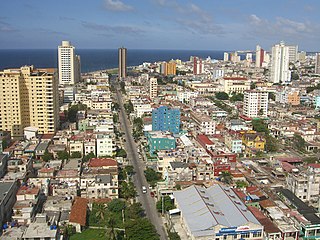
Havana is the capital and largest city of Cuba. The heart of the La Habana Province, Havana is the country's main port and commercial center. It is the most populous city, the largest by area, and the second largest metropolitan area in the Caribbean region. The population in 2012 was 2,154,454 inhabitants, and its area is 728.26 km2 (281.18 sq mi) for the capital city side and 8,475.57 km2 for the metropolitan zone.

Carlos Yunior Acosta Quesada is a Cuban-British ballet director and retired dancer who is director of the Birmingham Royal Ballet. He danced with many companies, including the English National Ballet, National Ballet of Cuba, Houston Ballet and American Ballet Theatre. He was a permanent member of The Royal Ballet from 1998 to 2015. In 2003, he was promoted to principal guest artist, a rank that reduced his commitment, enabling him to concentrate on a growing schedule of international guest appearances and tours. He celebrated his farewell after 17 years at The Royal Ballet, dancing his last performance in November 2015 in Carmen, which he both choreographed and starred in.

Plaza de la Revolución, "Revolution Square", is a municipality and a square in Havana, Cuba.
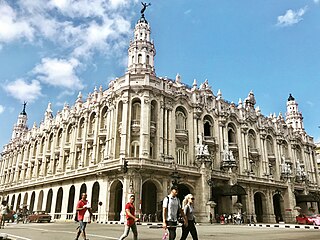
Gran Teatro de La Habana is a theater in Havana, Cuba, home to the Cuban National Ballet. It was designed by the Belgian architect Paul Belau and built by Purdy and Henderson, Engineers in 1914 at the site of the former Teatro Tacón. Its construction was paid for by the Galician immigrants of Havana to serve as a community-social center. Located in the Paseo del Prado, its facilities include theatres, a concert hall, conference rooms, a video screening room, as well as an art gallery, a choral center and several rehearsal halls for dance companies. It hosts the International Ballet Festival of Havana every two years since 1960.
Max Borges Jr., born Max Borges Recio, was a Cuban architect best known for his work in Havana in the 1940s and 1950s. He later moved to the United States.

The Cuban National Ballet School(Escuela Nacional Cubana de Ballet) in Havana, with approximately 3,000 students is the biggest ballet school in the world and the most prestigious ballet school in Cuba. It was directed by Ramona de Sáa until her death on 17 April 2024.

Modelo Brewery, designed by the Cuban architect Enrique Luis Varela, was built in 1948 for Compañia Ron Bacardi S.A. Its address is the corner of 52 and Carretera Central, Cotorro, Havana, Cuba. In 1952, Ernest Hemingway featured Hatuey beer in his book The Old Man and the Sea. When he was awarded the Nobel Prize for Literature, the company threw him a party at the Modelo Brewery. Hemingway was a frequent patron of the brewery since it was located near to his home in Havana at Finca Vigía.
Hugo Consuegra was a Cuban-born artist and architect who, in 1953, became one of the founding members of Los Once, a group of young abstract expressionist artists which included the core members Guido Llinás, Raul Martinez, Tomás Oliva and Antonio Vidal. The group broke away from the representational style prevalent at the time in Cuba and produced its largest volume of work between 1953 and 1955. Consuegra and four of the original 11 continued to exhibit in what became known as the post-revolutionary avant-garde movement in Cuba. Consuegra was also a Professor of Art History at Havana University’s School of Architecture (1960–5).

The National Art Schools of Cuba is one of the most important educational institutions of the Cuban nation and has been declared as "National Monument".
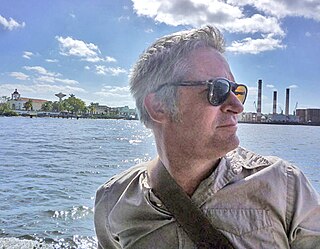
Felipe Dulzaides is a Cuban-born American contemporary artist. His practice includes installation, photography, video, drawing, sculpture and performance. Two important cities of reference of his works are San Francisco, California and Havana, Cuba.

Ricardo Porro Hidalgo was a Cuban-born architect. He graduated in architecture from the Universidad de la Habana in 1949 and built this year his first project Villa Armenteros in Havana, following which he spent two years in post-graduate studies at the Institute of Urbanism at the Sorbonne.
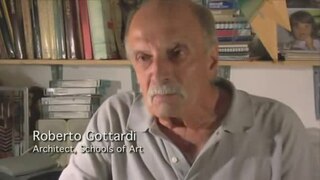
Roberto Gottardi was an Italian-Cuban architect.

Unfinished Spaces is a 2011 documentary film about the revolutionary design of the National Art Schools (Cuba), directed by Alysa Nahmias and Benjamin Murray. The film tells the dramatic story of the art schools from their founding by Fidel Castro and Che Guevara to their eventual abandonment and fall into ruin and recent efforts to restore them.

Martín Domínguez Esteban was a Spanish architect.
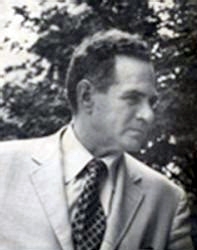
Mario Romañach (1917–1984) was a Cuban modernist architect, planner, and university professor.

Alysa Nahmias is an American filmmaker and the founder of Ajna Films.

Architecture of Cuba refers to the buildings, structures and architectural history throughout the Caribbean island nation of Cuba. The unique mix of cultural and artistic influences throughout history have led to Cuba being renowned for its eclectic and diverse architecture, which can be defined as a unique fusion of numerous well-studied architectural styles from around the world.

The Colegio de Belén is a private religious school in Marianao, Havana, located between 45th and 66th streets, next door to the Tropicana nightclub,. It was designed in 1925 by the architect Leonardo Morales y Pedroso and his brother the engineer Luis Morales y Pedroso of the firm Morales y Compañía Arquitectos.
Nicolás Quintana was a Cuban-born architect and one of the frontrunners of modernist architecture in Cuba.
Frank Martínez was a Cuban-born architect and a leading figure in Cuban modernist architecture.